Travel
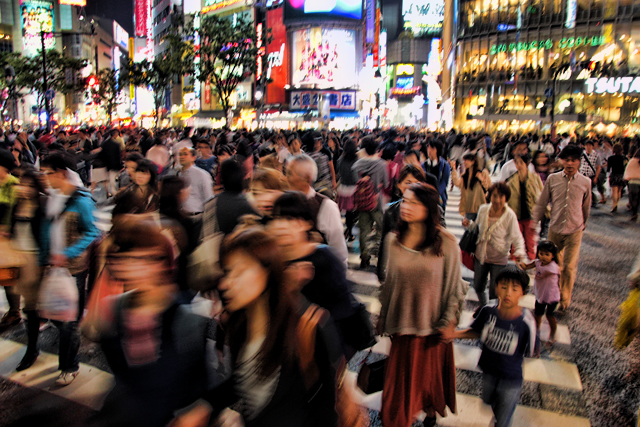
Shibuya is the point zero of Japanese fashion and the Mecca of chic; and it fascinated me so much, I must be a Shibuya girl in a parallel universe or something. The way these girls dress, the contact lenses that make the eyes look bigger, all that lace, ruffles, colorful socks, and ribbons, make for the most elegant casual outfits I've ever seen. I get goose bumps every time I remember the time I spent shopping in the trendy boutiques at Shibuya 109. I left part of my heart there, and ever since I got back home all I want is to go back.
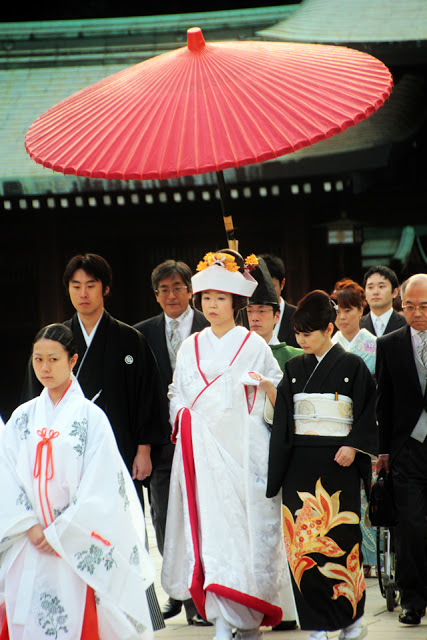
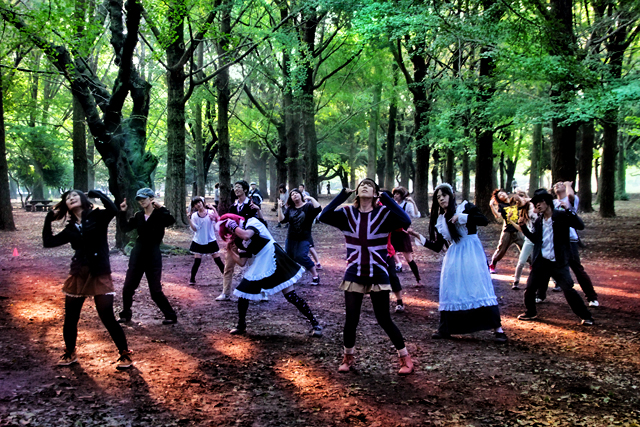
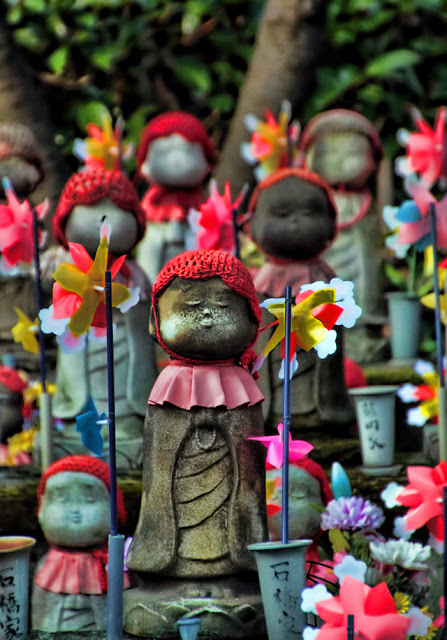
Next to Tokyo Tower, the Zojoji Temple is a Buddhist temple, head of the Jodo sect in the Kanto Region. The temple dates back to the 14th century though it was moved to its present location at the end of the 16th century.
The temple was badly damaged during the WWII and, therefore most of the buildings are reconstructions, nevertheless stunning. The temple is surrounded by a forest and in spite of the heavy traffic going on around it, the place has this serene atmosphere that invites the visitors to meditation and contemplation - the cats leisurely napping on the temple's grounds are proof of it.
Behind the Main Hall there is a cemetery and six Tokugawa shoguns are buried here. But for me, the most unique feature of this temple remains the Unborn Children Garden. Rows of beautiful stone statues represent the unborn babies, be them miscarried, aborted or stillborn. These statues decorated by the parents with baby clothes and windmills are like little angels that supposedly help the children with the transition to the afterlife. It is a surreal sight, but at the same time this is the saddest place we visited in Tokyo.
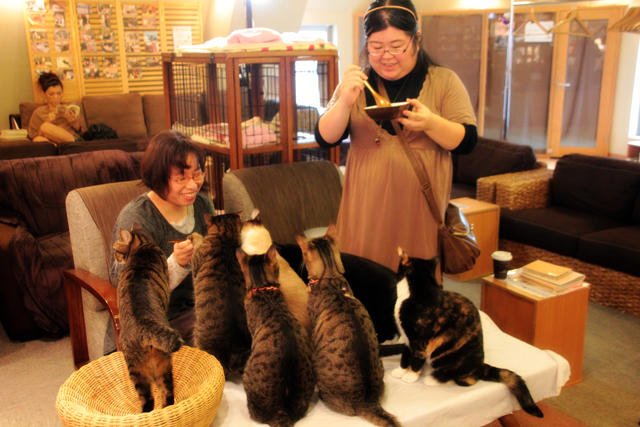
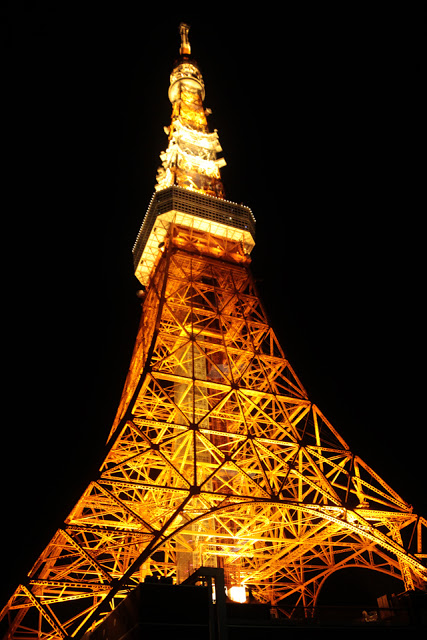
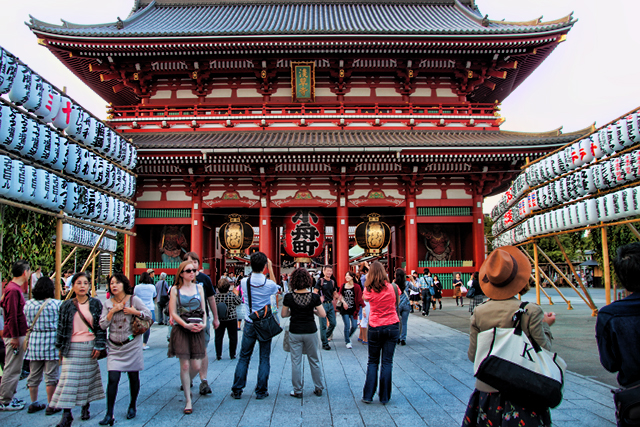
This is Tokyo's oldest temple and the Kaminarimon (Thunder Gate) is the symbol of the city. Leading to the temple is a 200m shopping street where you can buy anything from snacks, to Hello Kitty dolls, trinkets and Buddhist scrolls. Close to the Main Hall are the Asakusa Shrine and the 5 storied pagoda. Both the temple grounds and the shopping street were extremely busy when we visited.
This was the first Buddhist temple we went to in Japan and I was surprised to see that the worshipers clearly outnumbered the tourists. In spite of being a super modern metropolis, the inhabitants of Tokyo are still clinging to their traditions (more than the western world, anyways). The story behind this temple is an interesting one as well. In the 7th century, two fishermen found the statue of Kannon in the river while fishing. The village headman recognized the deity represented in the statue and decided to transform his own house into a temple.
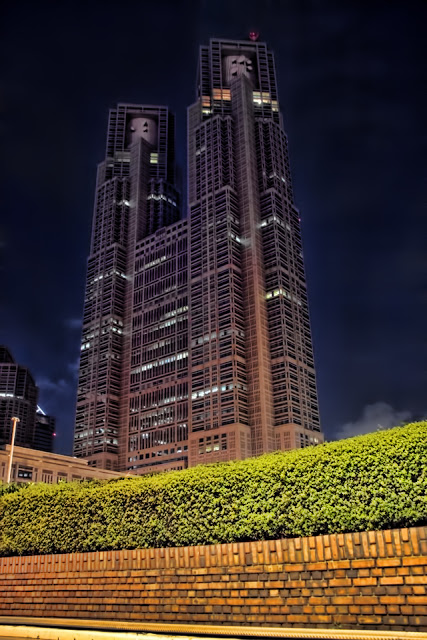
This is Tokyo's City Hall, and with its 243m, it is the 7th tallest building in Japan. Built to resemble a computer chip and also a Gothic cathedral, it makes for one of the best observation decks in Tokyo. On a clear day visitors can even spot Mt. Fuji far in the distance, but the views of Tokyo's skyline are just as breathtaking at night as well.
There are quite a few buildings in Tokyo that feature an observation deck from where you can admire the city from above. Some do it for free, as it's the case of Tokyo Metropolitan Government Building, others charge a fee. My point is, viewing this immense city from the top is quite a different experience than seeing it from ground level. While the latest gives you the feeling that the possibilities are endless, the views from the top give you a sense of endless discovery.
Taking a no-stops elevator ride all the way to the last floor is an experience in itself too. Apart from not making any noises during the few seconds it takes to travel over 200 metes, the elevator doesn't seem to be moving either.
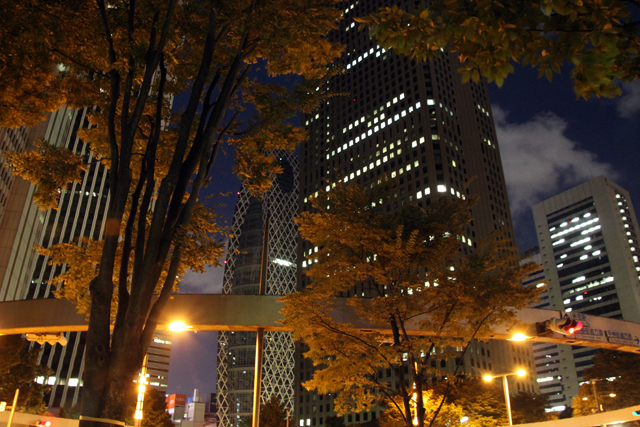
Far from being a city that never sleeps, Tokyo can get surprisingly quiet at night. As we walked the streets of this metropolis around 10PM, both the buildings aiming for the sky and the sidewalks seemed to be falling asleep.
OK, I'm not talking about Shibuya or Ikebukuro here, which are the gathering places of the young and restless, but I am talking about the residential and business districts. There is an hour between dusk and the end of office hours when Tokyo's skyscrapers are beautifully lit and are a head turner. But as the night gets older, people go home and the tall buildings become black monsters against the sky.
This contrast between something so huge and full of life and the stillness it can all come to never ceases to amaze me. I believe you haven't fully experienced Tokyo until you walked its streets at night and saw what sudden transformations this amazing city is capable of.
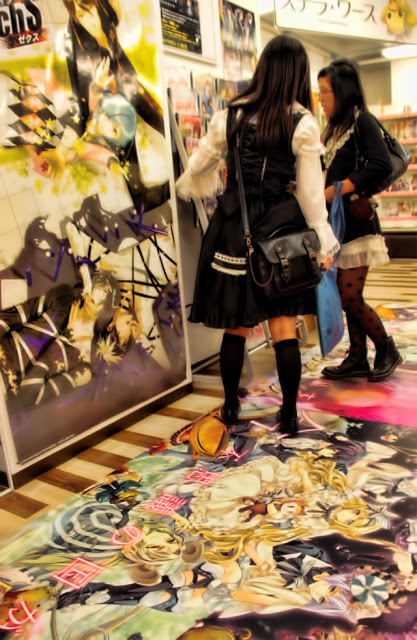
I don't read manga, though to be completely honest with you there are some Japanese anime movies that I really love. But I believe any traveler should enter at least one manga shop, and if you do so, please make sure you pick one that is a 7-8 storey building dedicated entirely to the genre. You don't have to buy a book. All you have to do is look around and observe and emerge yourself in the local culture.
I never realized how inspired from reality manga is, nor how much influence the manga culture has upon the daily life of the young Japanese people, until I arrived in Tokyo. My first impression about Tokyo was actually "It's a manga world!", and to a certain extent, it is.
Way too bright neon lights, colorful drawings that cover even the floors of the shops, the loud TVs that each play a different movie all at once, resulting in a babel of voices, and the impossible to read (for me) books, combine in a wonderful way with the boys and girls, women and men, all dressed in that school uniform inspired fashion I came to love so much.
I'm sure any European bookstore dreams about having this many and dedicated customers! The Japanese really read a lot and it is pretty common to see people of all ages reading manga on trains or subway.
This is a subjective list of the top 10 places to visit in Tokyo. However, there's so much more to be experienced and discovered in this amazing city. Spend the night in a ryokan, have lunch or dinner in a hole in the wall noodle shop frequented by locals. Ty to blend in, attend a festival (there are plenty to choose from - we went to four - Ikebukuro Autumn Festival, Jidai Matsuri in Kyoto, a street festival in Nagoya and a festival in Arashiyama) and go on a day trip outside Tokyo. The possibilities are endless. For more inspiration you can further check this list of 25 things to do in Tokyo.
USEFUL INFORMATION:
- 8 Places You Must Visit In Japan
Japan was not very high on my list of priorities, but luckily it was right at the top of my husband's bucket list. So when we planned our first trip to Asia, we both compromised a little and we tailored an itinerary that included both Japan and...
- Visiting A Cat Café In Tokyo, Japan
Ever since I found out about the existence of cat cafés back in 2010, I wanted to go to Japan to visit one. I'm a crazy cat lady, and this was actually the main reason I wanted to travel half way around the globe, not the stunning...
- Planning Our First Trip To Asia. In Style!
We have some great news! After traveling through 23 European countries and 173 cities, we are finally getting out of Europe! Just thinking about it makes us feel goosebumps. But we are not only going to Asia, we are also doing it in style. First we'll...
- Mandarin Oriental Tokyo Hotel For Rent For $671,000
Got some $671,000 to spare? Because if you do, the entire 5 luxurious stars of the Mandarin Oriental Tokyo Hotel could be yours for a night. Well, to be more precise, 21 hours. You can invite 500 of your closest friends and throw a wild cocktail party...
- Be A Guide Of Your Country Like Shotaro Kajitani! Check This Interview!
This weekend I went to Japanese Disney Sea for the first time and my friend Shotaro was my guide in there. He took me and other friend to many places in the park, including The Tower of Terror where we take an elevator that drops very quickly. Although...
Travel
Top 10 Places To Visit in Tokyo
I love Tokyo! I never thought I would say this, but after 10 days spent there, Tokyo became my favorite city in the world (over Paris!!). I always was a city girl, and though I love nature, I could never live too far, nor too long away from the concrete and electric jungle. And I'm afraid I will never again be able to stay away for too long from Tokyo - the most civilized and well-organized jungle of them all. The most famous of Tokyo's attractions can be reached by subway or train, and though huge and a bit intimidating at first, you will get anywhere in no time.
Tokyo was the first city we visited in Asia, and comparing it with all the other places we've visited before (and after), Tokyo is a different world altogether. If I were to recommend you only one city to visit in the world (given that you are not Japanese), I would recommend you Tokyo. You get the idea, I'm in love with this city! And this is not only because for me it represents the peak of civilization, law, order and fashion, it is also because from all the places I've visited so far, this is the one that stands out most, in all the good ways.
The following list of places to visit in Tokyo is based on our personal experience and organized in no particular order. Please feel free to add your favorite places in Tokyo in the comment section below.
THINGS TO DO & PLACES TO VISIT IN TOKYO
Shibuya 109 & Shibuya Crossing

Shibuya is the point zero of Japanese fashion and the Mecca of chic; and it fascinated me so much, I must be a Shibuya girl in a parallel universe or something. The way these girls dress, the contact lenses that make the eyes look bigger, all that lace, ruffles, colorful socks, and ribbons, make for the most elegant casual outfits I've ever seen. I get goose bumps every time I remember the time I spent shopping in the trendy boutiques at Shibuya 109. I left part of my heart there, and ever since I got back home all I want is to go back.
The Shibuya Crossing is a couple of minutes from Shibuya 109 and just outside Shibuya Station served by JR Yamanote Line. This crossing, made famous by the 'Lost in Translation' movie, is one of the busiest in the world and the quintessence of organized chaos. The traffic lights from all directions turn red all at the same time and for the next couple of minutes people invade the crossing like spilled beans out of a can.
You can observe the spectacle of lights and people from the Starbucks on the crossing's north side or you can experience the madness for yourself, which in my opinion is far better. My husband and I crossed quite a few times here just for fun and not one single time did we bump into another person or people bumped into us. Everybody matched their peace at the speed of the person in front, walking at unison, on lanes. Now if this is not the ultimate example of civilization, I don't know what is.
Meiji Shrine (traditional Tokyo)

Meiji Shrine is a Shinto shrine located in the Shibuya Ward, in the middle of a beautiful forest with huge Torii gates leading to the main hall and it is accessible from the Harajuku Station on the JR Yamanote Line. Dedicated to the deified spirits of Emperor Meiji and his wife, it is now a favorite place for wedding ceremonies.
We were lucky to witness such a procession. Led by two shrine priests and two shrine maidens, the couple followed under a big red umbrella. Family and friends came next, but we were surprised by both the reduced numbers of participants and by the lack of joy on their faces. Apparently Shinto wedding ceremonies are very solemn and quite unique.
Also there were lots of worshipers ruminating around the shrine's grounds, and many of the ladies and young girls were dressed in gorgeous kimonos. As opposed to the nearby Yoyogi Park, Meiji Shrine is the place to go contemplate the old Japan and Japanese traditions.
We were lucky to witness such a procession. Led by two shrine priests and two shrine maidens, the couple followed under a big red umbrella. Family and friends came next, but we were surprised by both the reduced numbers of participants and by the lack of joy on their faces. Apparently Shinto wedding ceremonies are very solemn and quite unique.
Also there were lots of worshipers ruminating around the shrine's grounds, and many of the ladies and young girls were dressed in gorgeous kimonos. As opposed to the nearby Yoyogi Park, Meiji Shrine is the place to go contemplate the old Japan and Japanese traditions.
Yoyogi Park on a Sunday

There is no better place for people watching in Tokyo than the Yoyogi Park. The park is very popular with young Japanese people, especially on Sundays, and you can spot the unleashed wackiness of an otherwise reserved nation.
We spotted from shy Lolitas and classy girls drinking red wine from crystal glasses while seated on a picnic cloth, to couples in love, club meetings, teenagers rehearsing plays, and homeless people giving a ride to their cats in supermarket trolleys. Everything goes and nobody feels out of place.
The park is pretty huge and doesn't give the feeling of being crowded at all, but then again, this is part of a special Japanese talent - in spite of Tokyo being the world's most populous metropolis, we never felt overwhelmed by the number of people around us.
Zojoji Temple (traditional Tokyo)

Next to Tokyo Tower, the Zojoji Temple is a Buddhist temple, head of the Jodo sect in the Kanto Region. The temple dates back to the 14th century though it was moved to its present location at the end of the 16th century.
The temple was badly damaged during the WWII and, therefore most of the buildings are reconstructions, nevertheless stunning. The temple is surrounded by a forest and in spite of the heavy traffic going on around it, the place has this serene atmosphere that invites the visitors to meditation and contemplation - the cats leisurely napping on the temple's grounds are proof of it.
Behind the Main Hall there is a cemetery and six Tokugawa shoguns are buried here. But for me, the most unique feature of this temple remains the Unborn Children Garden. Rows of beautiful stone statues represent the unborn babies, be them miscarried, aborted or stillborn. These statues decorated by the parents with baby clothes and windmills are like little angels that supposedly help the children with the transition to the afterlife. It is a surreal sight, but at the same time this is the saddest place we visited in Tokyo.
Stop by a cat café

Even before going to Japan I knew there were two things I wouldn't miss for anything in the world - eat sushi and visit a cat café. I'm a self declared crazy cat lady (my husband totally agrees) and indulging on my petting urges on the other side of the world was something I was really looking forward to. So on our second day in Tokyo when we found a cat cafe in Ikebukuro, at the 5th floor of an office building, I didn't hesitate. In what is probably the most purrfect 500sqm in Tokyo, there were comfy sofas, manga books, cat toys and more kitty cats than people. The puffy balls of fur came in all colors and fur lengths, all adult, some of a certain pedigree, others not so much.
We had to take off our shoes before entering and we were given slippers instead. There was a set fee for every 10 minutes spent in the company of the cute kitties and there were set rules we were given to read in English, as the staff spoke only Japanse and the cats only Meow.
We agreed not to pick up the cats, nor to bother them if they showed signs of being annoyed and they let us in. All in all, the atmosphere was very quiet, just right for a nap actually, and well under the noise level of any other café - everybody was whispering. There was a juice and tea vending machine on the premises and we could take photos without flash. For an additional cost you could even buy cat food for the kitties. Nowhere and never in history were cats treated with more respect.
Nevertheless, like any royalty born or made, these cats looked bored. They were't impressed with the cat toys I flashed in front of them; most of the time they didn't even seem to notice me and they definitely didn't show much interest in being petted. In spite of being an overpriced experience that involved more petting and less playing, I would recommend it to any cat lover out there.
Tokyo Tower & Tokyo Skytree

Tokyo Tower probably gained it's fame due to its similarity with Eiffel Tower and up till now it has drawn many tourists. But my question is, now that a new kid came into town will it steal the show? Tokyo Skytree (634m) completed in 2012 and Tokyo Tower (333m) are the two tallest artificial structures in Japan. While the orange and white Tokyo Tower is wrapped in a warm light at night, the Skytree is painted in a circus of lights every evening. Time will tell which will become the people's favorite place in Tokyo for panoramic views.
Senso-ji Temple (traditional Tokyo)

This is Tokyo's oldest temple and the Kaminarimon (Thunder Gate) is the symbol of the city. Leading to the temple is a 200m shopping street where you can buy anything from snacks, to Hello Kitty dolls, trinkets and Buddhist scrolls. Close to the Main Hall are the Asakusa Shrine and the 5 storied pagoda. Both the temple grounds and the shopping street were extremely busy when we visited.
This was the first Buddhist temple we went to in Japan and I was surprised to see that the worshipers clearly outnumbered the tourists. In spite of being a super modern metropolis, the inhabitants of Tokyo are still clinging to their traditions (more than the western world, anyways). The story behind this temple is an interesting one as well. In the 7th century, two fishermen found the statue of Kannon in the river while fishing. The village headman recognized the deity represented in the statue and decided to transform his own house into a temple.
Tokyo Metropolitan Government Building No 1

This is Tokyo's City Hall, and with its 243m, it is the 7th tallest building in Japan. Built to resemble a computer chip and also a Gothic cathedral, it makes for one of the best observation decks in Tokyo. On a clear day visitors can even spot Mt. Fuji far in the distance, but the views of Tokyo's skyline are just as breathtaking at night as well.
There are quite a few buildings in Tokyo that feature an observation deck from where you can admire the city from above. Some do it for free, as it's the case of Tokyo Metropolitan Government Building, others charge a fee. My point is, viewing this immense city from the top is quite a different experience than seeing it from ground level. While the latest gives you the feeling that the possibilities are endless, the views from the top give you a sense of endless discovery.
Taking a no-stops elevator ride all the way to the last floor is an experience in itself too. Apart from not making any noises during the few seconds it takes to travel over 200 metes, the elevator doesn't seem to be moving either.
Tokyo by night

Far from being a city that never sleeps, Tokyo can get surprisingly quiet at night. As we walked the streets of this metropolis around 10PM, both the buildings aiming for the sky and the sidewalks seemed to be falling asleep.
OK, I'm not talking about Shibuya or Ikebukuro here, which are the gathering places of the young and restless, but I am talking about the residential and business districts. There is an hour between dusk and the end of office hours when Tokyo's skyscrapers are beautifully lit and are a head turner. But as the night gets older, people go home and the tall buildings become black monsters against the sky.
This contrast between something so huge and full of life and the stillness it can all come to never ceases to amaze me. I believe you haven't fully experienced Tokyo until you walked its streets at night and saw what sudden transformations this amazing city is capable of.
A manga shop

I don't read manga, though to be completely honest with you there are some Japanese anime movies that I really love. But I believe any traveler should enter at least one manga shop, and if you do so, please make sure you pick one that is a 7-8 storey building dedicated entirely to the genre. You don't have to buy a book. All you have to do is look around and observe and emerge yourself in the local culture.
I never realized how inspired from reality manga is, nor how much influence the manga culture has upon the daily life of the young Japanese people, until I arrived in Tokyo. My first impression about Tokyo was actually "It's a manga world!", and to a certain extent, it is.
Way too bright neon lights, colorful drawings that cover even the floors of the shops, the loud TVs that each play a different movie all at once, resulting in a babel of voices, and the impossible to read (for me) books, combine in a wonderful way with the boys and girls, women and men, all dressed in that school uniform inspired fashion I came to love so much.
I'm sure any European bookstore dreams about having this many and dedicated customers! The Japanese really read a lot and it is pretty common to see people of all ages reading manga on trains or subway.
***
This is a subjective list of the top 10 places to visit in Tokyo. However, there's so much more to be experienced and discovered in this amazing city. Spend the night in a ryokan, have lunch or dinner in a hole in the wall noodle shop frequented by locals. Ty to blend in, attend a festival (there are plenty to choose from - we went to four - Ikebukuro Autumn Festival, Jidai Matsuri in Kyoto, a street festival in Nagoya and a festival in Arashiyama) and go on a day trip outside Tokyo. The possibilities are endless. For more inspiration you can further check this list of 25 things to do in Tokyo.
USEFUL INFORMATION:
Where to stay in Tokyo:
Ryokan Asakusa Mikawaya Honten - a budget-friendly Japanese inn located in the traditional area of Asakusa. They have Japanese style rooms, ideal for cultural immersion.
Tokyu Stay Shinjuku - newly opened mid-range hotel in Tokyo's commercial district. Great location and free WiFi.
Ryokan Asakusa Mikawaya Honten - a budget-friendly Japanese inn located in the traditional area of Asakusa. They have Japanese style rooms, ideal for cultural immersion.
Tokyu Stay Shinjuku - newly opened mid-range hotel in Tokyo's commercial district. Great location and free WiFi.
How to move around:
The best way to travel around Japan is by using a Japan Rail Pass, a very convenient and economical way to see the country. For train route ideas and city guides, you can check out Japan by Rail.
The best way to travel around Japan is by using a Japan Rail Pass, a very convenient and economical way to see the country. For train route ideas and city guides, you can check out Japan by Rail.
Further readings:
Before you go to Japan we highly recommend you read the following books for a better understanding of the Japanese culture and lifestyle:
- A Geek in Japan (our favourite book on Japan!)
- Lonely Planet Japan (up-to-date advice on what to see and do in Japan)
- Japan: The Essential Guide to Customs & Culture (learn how to blend in by understanding the weird, wonderful and downright odd Japanese customs).
Disclaimer: Some of the links in this article are affiliate links. If you buy via them, I will get some coffee money at no additional cost to you. Thank you for helping me stay awake!
- A Geek in Japan (our favourite book on Japan!)
- Lonely Planet Japan (up-to-date advice on what to see and do in Japan)

- Japan: The Essential Guide to Customs & Culture (learn how to blend in by understanding the weird, wonderful and downright odd Japanese customs).
Disclaimer: Some of the links in this article are affiliate links. If you buy via them, I will get some coffee money at no additional cost to you. Thank you for helping me stay awake!
- 8 Places You Must Visit In Japan
Japan was not very high on my list of priorities, but luckily it was right at the top of my husband's bucket list. So when we planned our first trip to Asia, we both compromised a little and we tailored an itinerary that included both Japan and...
- Visiting A Cat Café In Tokyo, Japan
Ever since I found out about the existence of cat cafés back in 2010, I wanted to go to Japan to visit one. I'm a crazy cat lady, and this was actually the main reason I wanted to travel half way around the globe, not the stunning...
- Planning Our First Trip To Asia. In Style!
We have some great news! After traveling through 23 European countries and 173 cities, we are finally getting out of Europe! Just thinking about it makes us feel goosebumps. But we are not only going to Asia, we are also doing it in style. First we'll...
- Mandarin Oriental Tokyo Hotel For Rent For $671,000
Got some $671,000 to spare? Because if you do, the entire 5 luxurious stars of the Mandarin Oriental Tokyo Hotel could be yours for a night. Well, to be more precise, 21 hours. You can invite 500 of your closest friends and throw a wild cocktail party...
- Be A Guide Of Your Country Like Shotaro Kajitani! Check This Interview!
This weekend I went to Japanese Disney Sea for the first time and my friend Shotaro was my guide in there. He took me and other friend to many places in the park, including The Tower of Terror where we take an elevator that drops very quickly. Although...
